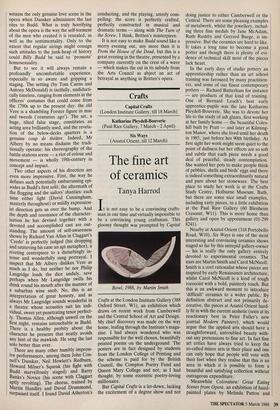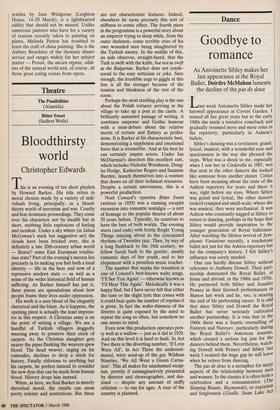Crafts
Capital Crafts (London Institute Gallery, till 18 March) Katharine Pleydell-Bouverie (Paul Rice Gallery, 7 March – 2 April) Six Ways (Anatol Orient, till 12 March)
The fine art of ceramics
Tanya Harrod
It is not easy to be a convincing crafts- man in our time and virtually impossible to be a convincing young craftsman. This gloomy thought was prompted by Capital Bowl, 1988, by Martin Smith Crafts at the London Institute Gallery (388 Oxford Street, W1), an exhibition which draws on recent work from Camberwell and the Central School of Art and Design. My chief discovery was made on the way home, leafing through the Institute's maga- zine. I had always wondered who was responsible for the well chosen, beautifully printed poems on the underground. The posters are in fact designed by students from the London College of Printing and the scheme is paid for by the British Council, the Compton Poetry Fund and Queen Mary College and not, as I had thought, by some eccentric poetry-loving millionaire.
But Capital Crafts is a let-down, lacking the excitement of a degree show and not doing justice to either Camberwell or the Central. There are some pleasing examples of metalwork, whilst the jewellery, includ- ing three fine medals by Jane McAdam, Ruth Rushby and Gerrard Burge, is im- pressive. But the ceramics are hard to like. It takes a long time to become a good potter and though there is plenty of evi- dence of technical skill most of the pieces lack heart.
In the early days of studio pottery an apprenticeship rather than an art school training was favoured by many practition- ers, and some of our finest contemporary potters — Richard Batterham for instance — are products of that kind of training. One of Bernard Leach's best early apprentice-pupils was the late Katharine Pleydell-Bouverie. She was to devote her life to the study of ash glazes, first working at her family home — the beautiful Coles- hill built by Pratt — and later at Kilming- ton Manor, where she lived until her death in 1985, just before her 90th birthday. At first sight her work might seem quiet to the point of dullness but her effects are so soft and subtle that each piece needs a good deal of peaceful, steady contemplation. She wanted her pots to make people think of pebbles, shells and birds' eggs and there is indeed something extraordinarily natural and pure about her stoneware. The best place to study her work is at the Crafts Study Centre, Holburne Museum, Bath, but there are some nice small examples, including early pieces, in a little exhibition at the Paul Rice Gallery (60 Blenheim Crescent, W11). This is more home than gallery and open by appointment (01-299 8241).
Nearby at Anatol Orient (318 Portobello Road, W10), Six Ways is one of the most interesting and convincing ceramics shows staged so far by this intrepid gallery-owner — his is really the only gallery entirely devoted to experimental ceramics. The stars are Martin Smith and Carol McNicoll. Smith is a cool rationalist whose pieces are inspired by early Renaissance architecture, whilst Carol McNicoll is a kind of tough rococoist with a bold, painterly touch. But this is an awkward moment to introduce 'difficult' ceramics to a wider public. By definition abstract and not primarily de- corative, the pieces at Anatol Orient hard- ly fit in with the current aeshetic (seen at its reactionary best in Peter Fuller's new journal Modern Painters), which would argue that the applied arts should have a straightforward, untroubled beauty with- out any pretensions to fine art. In fact fine art critics have always tried to keep the so-called minor arts in their place and one can only hope that people will vote with their feet when they realise that this is an area in which it is possible to form a beautiful and satisfying collection without outrageous expenditure.
Meanwhile Coloratura: Great Eating Scenes from Opera, an exhibition of hand- painted plates by Melinda Patton and textiles by Jane Wildgoose (Leighton House, 14-29 March), is a lighthearted oddity that should not be missed. Unlike numerous painters who have for a variety of reasons recently taken to painting on plates, Melinda Patton has troubled to learn the craft of china painting. She is the Aubrey Beardsley of the thematic dinner service and ranges widely for her subject matter — Proust, the ancien regime, oddi- ties of the natural world and, of course, all those great eating scenes from opera.



















































 Previous page
Previous page